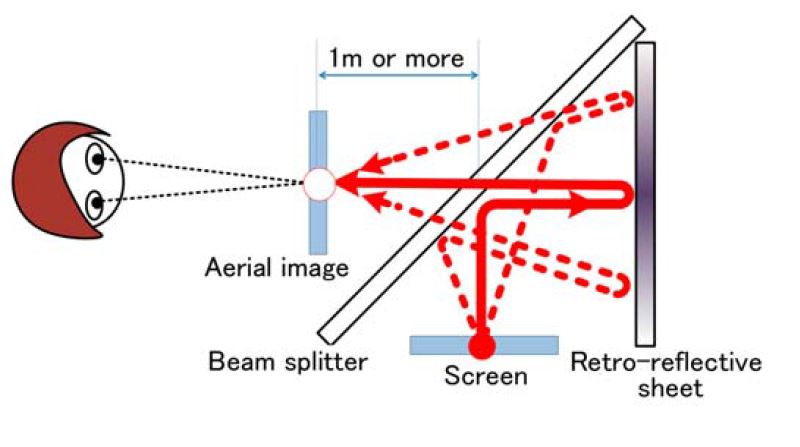'Aerial display' projects images into thin air
Mitsubishi Electric Corporation has developed an 'aerial display' that projects images measuring approximately 56" diagonally (886x1,120mm) into midair. This display will have a wide range of potential applications and Mitsubishi Electric will proceed with development with the aim of seeing the technology commercially available from 2020 onward in digital signage, entertainment and other sectors.
The two key components for the technology are a beam splitter - an optical device that divides incoming light into reflected light and transmitted light - and a retro-reflective sheet - an optical device that reflects incoming light back in the incident direction. A beam splitter and retro-reflective sheet are arranged in a set with a screen. The light that is projected from the screen is reflected by the beam splitter and then subsequently by the retro-reflective sheet. The result is that the light reconverges as an image that appears to be floating in the air (Figure 2).
To realise this technology, Mitsubishi Electric developed an optical simulation programme to calculate the optimal arrangement of the screen, beam splitter and retro-reflective sheet to achieve an aerial display measuring approximately 56" diagonally (886x1,120mm) projected at least one meter from the beam splitter.
One problem was that people who are not accustomed to focusing their eyes on open space find it difficult to understand where an aerial image is being displayed without physical cues. To address this, Mitsubishi Electric developed a system that uses a projector to display guide images on the walls on both sides of the aerial image to indicate the position. This system divides an input into left and right guide images and the aerial image, but links the three seamlessly for high entertainment value. Factoring in the size of the guide images, the total display area measures approximately 90" diagonally (1,992x1,120mm).
Mitsubishi Electric is researching and developing the display technologies that society will demand in the near future. This technology is expected to have many potential applications requiring highly realistic visual expression, for example displaying large images in the air above a stadium or displaying life-sized images of people for remote communication. In April 2015, Mitsubishi Electric began joint research on aerial displays with Hirotsugu Yamamoto, an Associate Professor at the Graduate School of Engineering at Utsunomiya University, which has led to this development.






